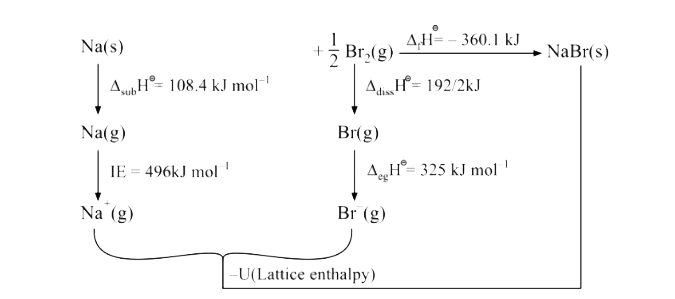Use the following data to calculate ΔlatticeHΘ for NaBr.ΔSubHΘ for sodium metal =108.4kJmol−1, ionisation enthalpy of sodium =496kJmol−1, electron gain enthalpy of bromine =−325kJmol−1, bond dissociation enthalpy of bromine =192kJmol−1,ΔfHΘ for NaBr(s)=−360.1kJmol−1
Given that, ΔsubH∘ for Na metal = 180.4kJmol−1
IE of Na=496kJmol−1,ΔegH∘ofBr=−325kJmol−1,ΔdissH∘ ofBr=192kJmol−1,ΔfH∘
For NaBr=360.1kJmol−1
Born-Haber cycle for the formation of NaBr is as

By applying Hess's law: ΔfH∘=ΔsubH∘+IE+ΔdissH∘+ΔegH∘+U
−360.1=108.4+496+96+(−325)−U
U=+735.5kJmol−1.
Topper's Solved these Questions
- THERMOCHEMISTRYBook:VMC MODULES ENGLISHChapter:THERMOCHEMISTRYExercise:LEVEL - 0 Long Answer Type
Explore 13 Videos
- THERMOCHEMISTRYBook:VMC MODULES ENGLISHChapter:THERMOCHEMISTRYExercise:LEVEL-1
Explore 75 Videos
- THERMOCHEMISTRYBook:VMC MODULES ENGLISHChapter:THERMOCHEMISTRYExercise:LEVEL - 0 Short Answer Type - I
Explore 8 Videos
- THEORY OF SOLUTIONSBook:VMC MODULES ENGLISHChapter:THEORY OF SOLUTIONSExercise:JEE Advanced (Archive)
Explore 31 Videos
- THERMODYNAMICSBook:VMC MODULES ENGLISHChapter:THERMODYNAMICSExercise:JEE ADVANCED (ARCHIVE)
Explore 44 Videos
Similar Questions
Knowledge Check
The enthalpy of solution of sodium chloride is 4kJmol−1 and its enthalpy of hydration of ion is −784kJmol−1. Then the lattice enthalpy of NaCl (in kJmol−1) is
Aa. +780 kJ mol−1Bb. +394 kJ mol−1Cc. +788 kJ mol−1Dd. +398 kJ mol−1
Calculate the heat of formation of NaCl from the following data:
Heat of sublimation of sodium = 108.5kJmol−1
Dissociation energy of chlorine = 243.0kJmol−1
lonisation energy of sodium = 495.8 kJ mol−1
Electron gain enthalpy of chlorine =−348.8kJmol−1
Lattice energy of sodium chloride =−758.7kJmol−1.
View SolutionLattice energy of NaCl(s) is -790 kJ mol−1 and enthalpy of hydration is -785 kJ mol−1. Calculate enthalpy of solution of NaCl(s).
View SolutionThe second electron gain enthalpies (in kJ mol−1) of oxygen and sulphur respectively are:
View SolutionThe second electron gain enthalpies (in kJ mol−1) of oxygen and sulphur respectively are:
View SolutionThe second electron gain enthalpies (in kJ mol−1) of oxygen and sulphur respectively are:
View SolutionΔfHɵ of hypothetical MX is −150kJmol−1 and for MX2 is −600kJmol−1. The enthalpy of disproportionation of MX is =−100xkJmol−1.
Find the value of x.
View SolutionThe electron gain enthalpy ( in kJ//mol ) of fluorine, chlorine, bromine and iodine, respectively ,are :
View Solution

